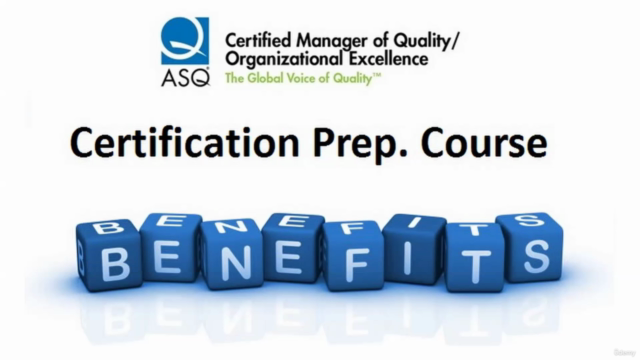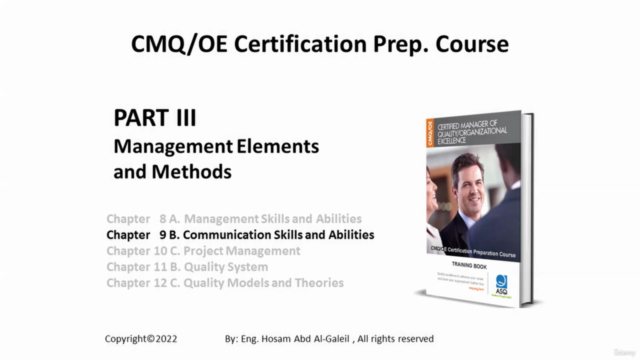CMQ/OE Certification Prep. - Part III

Why take this course?
-
Remember: The ISO 9000 standards are a series of proprietary standards and guidelines developed by the International Organization for Standardization (ISO) to help an organization demonstrate its ability to consistently provide products and services that meet customer and regulatory requirements. These standards form the basis for many other recognized standards like ISO 9001, which is the most widely implemented standard in the history of the standard, and is designed to provide tools for companies and organizations to ensure consistency and improvement of their products and services.
-
Understand: The Project Management Institute (PMI) outlines the project management lifecycle as a series of phases that includes:
- Initiation: Determine if a project should be undertaken, focusing on the feasibility analysis, opportunity assessment, and initial risk assessment.
- Planning: Define what is to be achieved in the project, who will do it, when it will be done, how much it will cost, and how performance will be monitored and controlled. This phase includes creating a Work Breakdown Structure (WBS), scheduling, estimating costs, defining communication plans, risk management, and stakeholder analysis.
- Execution: Implement the project plan, allocate resources, execute tasks, and achieve deliverables as planned.
- Monitoring and Controlling: Track, manage, and adjust all aspects of a project, including time, cost, and scope to ensure that the project continues to meet the needs for which it was undertaken, and to make sure that all project objectives are met on schedule and within budget.
- Closure: Formalize acceptance of deliverables, close out contracts, release project personnel/resources, and obtain final sign-off from the client or sponsor. Ensure that all project work is complete and that the product or service delivered meets the requirements agreed at the start.
-
Apply: When using project management tools such as risk assessment matrices, benefit-cost analysis, critical path method (CPM), Gantt charts, PERT (Program Evaluation Review Technique), and WBS for planning projects, it is crucial to understand how each tool can be applied in different contexts. For instance:
- A risk assessment matrix helps in identifying, analyzing, and evaluating risks that could affect a project. It allows for prioritizing risks based on their likelihood of occurring and their potential impact.
- A benefit-cost analysis is used to evaluate the potential benefits and costs of implementing a particular project, helping decision-makers determine if the project is viable from a financial perspective.
- The Critical Path Method (CPM) helps identify which activities are critical for the project to be completed on time, and provides a detailed schedule that allows for better resource allocation and risk management.
- A Gantt chart is used for scheduling and tracking progress of tasks in a project. It visually represents the timeline and duration of every task, making it easier to spot delays or overlaps in project planning.
- PERT provides an approach to identify critical tasks that are essential for completing a project on time. It also helps in scheduling and coordinating work for multiple team members by identifying tasks which can be done concurrently.
- A Work Breakdown Structure (WBS) breaks down the total scope of work to be carried out by the project into smaller, more manageable components. This facilitates planning at a detailed level and helps in managing individual tasks or deliverables.
-
Evaluate: When monitoring project activity, one would use tools such as cost variance analysis (CVA), which measures whether the costs of the project are within budget; milestones to ensure that the project is progressing according to the plan; and comparisons between actual versus planned budgets to assess financial performance against the project plan.
-
Create: Creating a quality mission and policy involves articulating the organization's commitment to meeting or exceeding customer expectations, ensuring compliance with regulatory requirements, and fostering continuous improvement across all processes. This policy should be documented and communicated throughout the organization, guiding all activities and decisions.
-
Analyze: When evaluating the effectiveness of a quality system, one would analyze data from various sources such as stakeholder feedback, warranty/return rates, product traceability and recall reports, and results from internal audits to identify areas for improvement. Management reviews are also a critical component where senior management periodically examines data, assesses performance against objectives, and identifies opportunities for quality enhancement.
-
Implement: Implementing the quality policy across the organization requires a systematic approach to ensure that all employees understand their roles in achieving quality objectives. This involves training, communication, and setting up a process for monitoring and reviewing performance continuously. It also includes establishing metrics and key performance indicators (KPIs) to measure progress towards quality goals and making necessary adjustments based on feedback and analysis of data.
In summary, applying project management principles and quality control methodologies requires understanding the various tools and processes involved, applying them appropriately, evaluating their effectiveness continuously, and creating a culture of quality that permeates all aspects of the organization's operations.
Course Gallery




Loading charts...